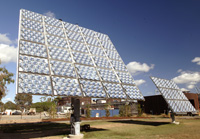Here’s a thought about generating electricity in the future from a bona fide expert: “I’d put my money on the sun and solar energy. What a source of power!”
That was Thomas Edison. The year was 1931.
For the better part of a century, Edison’s forecast went largely unrealized. But after years of optimistic talk and halting progress, solar is finally on the brink of going big-time. Slowly but steadily, solar has been in the throes of a quiet revolution, with efficiencies rising, costs falling, and new technological breakthroughs — including the recent development of nano-thin photovoltaic materials — all dramatically changing the game. Further driving a mass movement toward solar power are two economic imperatives: stratospheric oil prices, and the inevitability of Europe, the United States, and other industrialized nations soon putting a price on carbon to slow global warming.
Today, solar photovoltaic (p.v.) output still represents far less than one percent of the world’s four terawatts (four trillion watts) of electrical generating capacity. But according to some industry analysts, today’s size isn’t the story. The real story is what’s already been happening for more than a decade: a pattern of exponential p.v. growth that now promises to turn the world largely solar, at ever-accelerating speed. Overall bullishness about solar is widespread. BCC Research, a Massachusetts-based market research firm specializing in technology and energy, expects that the global solar sector will grow from $13 billion today to $32 billion by 2012.

“The Gun Has Gone Off” is the title of a report from respected industry tracker Michael Rogol and colleagues at the consulting firm Photon Consulting, summing up what seems to be a consensus among industry analysts. Some long-term growth predictions are simply jaw dropping, including estimates that non-polluting, carbon dioxide-free solar p.v. will become fully price-competitive with coal and nuclear power in most of the world sometime in the next decade or two — without any government or utility incentives. (This goal of so-called “grid parity” is the holy grail of solar enthusiasts.) And with solar costs continuing to plummet into the future, these analysts say, solar will out-compete other forms of electric generation on its own terms until it is preeminent.
We’re heard this kind of thing before. As long ago as the early 1980s, some prognosticators were predicting that solar p.v. manufacturing would reach 1 million watts of annual capacity before the end of the decade. But after President Ronald Reagan pulled the plug on federal solar subsidies initiated by the Carter administration, manufacturing slowed dramatically. And even if today’s prognosticators are correct, large hurdles remain, ranging from reducing manpower-intensive installation costs, to finding ways to store energy produced on sunny days for use at night or in cloudy weather.
So why the optimism surrounding solar today? Trend-trackers say that with little fanfare, solar p.v. production has accelerated into a pattern of rapid growth, with solar cell and assembled panel production roughly doubling every two years beginning in the mid 1990s. Today, solar p.v. appears to be firmly in a pattern of exponential growth and falling overall costs, a pattern that echoes the early mass-production years of past hyper-growth industries: automobiles in the early 20th century, televisions in mid-century, computers toward century’s end.
“It started from a tiny base,” says Ohio engineer David Heidenreich. “But it’s really incredible how long p.v. has been averaging a phenomenal growth rate. Everything we see says there’s no reason that can’t go on for a very long time.” Heidenreich was lead author of a recent industry analysis, entitled Exponential Solar, which provides a detailed synthesis of studies that analyze solar p.v. growth trends and places them in the context of historical studies of typical manufacturing growth curves.
Growth curve analysis began in the 1930s, with a study at the Wright Airplane Co. that showed how airframe costs fell at an exponential and predictable rate as production increased. Since then, a multitude of studies in a wide range of industries has shown a similar curve, with costs consistently dropping 20 to 30 percent with each doubling of manufacturing. The pattern can prevail for decades.
Consider, just as just one industrial precedent, the television set. In 1946, RCA sold about 10,000 televisions, at a cost of $325 (nearly $4,000 in 2008 dollars). By 1955, with annual U.S. production of 7.4 million sets, a bigger, better TV set cost about one-quarter of that, and a trend of falling costs and improving quality (Living Color!) continued. Ditto for computers, printers, cell phones.
Today, a fully installed solar p.v. system costs a homeowner $7 to $8 per watt of capacity, which means a total system cost of about $35,000 for a typical house. Assuming an average experience curve, that means that with rising output, costs should fall to about $4 per watt by 2012, then $2 per watt by 2021, continuing to fall steadily until reaching a cheaper than cheap 50 cents by 2039, according to Exponential Solar’s model.
In my home U.S. state of New Jersey, where kilowatts are relatively expensive, a rooftop, solar p.v. array folded into a 30-year mortgage would start to make sense without any utility or tax incentives at about $3 a watt, or sometime around 2015. In most of the United States, where power is cheaper, grid parity would come a few years later.

Paul Maycock, who directed the U.S. Department of Energy’s photovoltaic office during the Carter Administration, has since run his own p.v. consulting firm. He, too, is convinced that a pattern of exponential growth with falling costs is well in place. But he cautions that rapid solar growth since the mid 1990s has been supported by solar incentives in, principally, Germany and Japan, and more recently in such U.S. states as California and New Jersey.
“The incentives worked their magic — prices went down dramatically,” Maycock says, but he notes that some incentives will need to remain until p.v. reaches grid parity.
Maycock also warns that the trends only play out on average, over time, with inevitable bumps in the road. For example, solar panel prices stopped dropping in the mid-2000s, as soaring demand outstripped supplies of polysilicon, key to the manufacture of conventional cells. Now new silicon supplies are coming on line and price declines should follow.
Maycock — who worked for Texas Instruments in the chip giant’s early years — says the trend should more or less mimic the long pattern of growth and falling costs in the computer chip industry, which also relies on silicon wafers. The integrated circuit industry reduced costs largely by squeezing ever smaller circuits into chips. Solar can’t do that. But it can accomplish something similar by using ever-smaller amounts of material, since all of the electricity-generating action occurs near the surface. Manufacturers of conventional cells in the past have found ways to slice them thinner; newer “thin-film” production technologies use even less photovoltaic material to produce each watt of electricity. Maycock predicts that thin solar film will go from 10 percent of the market today to 30 to 35 percent in 2015.
That kind of growth doesn’t seem at all outlandish to Ray Kurzweil, an inventor and modern-day Edison in his own right. (Kurzweil developed, among other things, voice synthesizers, flat bed scanners, and early speech recognition technology). Noted for some prescient predictions — he forecast years ago that a little-known niche phenomenon called the Internet would one day transform the world — Kurzweil actually strikes an even more optimistic note.
Early this year, in a report commissioned by the National Association of Engineers, Kurzweil — working with a team of analysts that included Google founder Larry Page — concluded that innovations in areas such as nanotechnology will drive a robust growth in solar for years to come. Saying that “we are not that far away from a tipping point where energy from solar will be competitive with fossil fuels,” Kurzweil predicted that solar could meet 100 percent of the U.S.’s energy needs within 20 years.
The sort of innovation that could drive that explosion certainly appears to be underway. Maycock points to U.S.-based First Solar, the first to mass produce ultra-thin solar cells not made of conventional silicon, but of cadmium telluride (CdTe). The company has rapidly become the lowest-cost solar producer in the world, with its cell prices approaching half those of conventional manufacturers. Essentially, its process vaporizes the solar materials and deposits them on inexpensive glass at atom-thin levels. This year, another CdTe plant will begin operating at start-up AVA Solar in Colorado, which plans to ramp up rapidly to 200 million annual watts of production.
Silicon has hardly been knocked out of the game. Applied Materials, a leading supplier of equipment to the integrated circuit industry, has moved into automating solar cell production. In just two years, the company has already built 10 complete assembly lines for solar manufacturers in China and India. Early in 2008, Applied announced that an Indian customer had taken one of the biggest leaps yet, with a new order for a whopping 600 megawatts of p.v. manufacturing capacity, one-sixth of what the entire world produced last year.
California-based Nanosolar, meanwhile, last year began production of its own version of solar, using a material called copper indium gallium selenide (CIGS), which it grinds into infinitesimally tiny particles and prints as a “solar ink” on cheap foil panels. The company has a single printing press-like machine that it says can crank out a billion watts of solar power annually. Other young companies have developed flexible thin-film solar panels with inexpensive metal or plastic substrates that could be simply and cheaply installed. To date, most p.v. installations have been relatively small arrays attached to individual houses, schools, or commercial buildings. But utility scale installations are also growing.
The biggest p.v. technological promise may lie in systems that use mirrors or lenses to concentrate light on highly efficient multi-junction solar cells, vastly leveraging the power of the sun. Companies are now working on deploying these unique cells in concentrator arrays that amplify the sun from 500 to more than 1000 times. SolFocus, for example, with operations in both California and Spain, claims that its system, which rotates on two axes to perfectly track the sun from dawn to dusk, uses only 1/1000th of the solar p.v. material per watt generated of standard solar panels, with most of the system cheap and abundant aluminum and glass.
Meanwhile, p.v. has a competitor in solar thermal, a technology that uses mirrors to concentrate solar heat to produce steam, which can drive a conventional generator. Although it has not been growing at p.v.’s breakneck pace, rising fossil fuel prices seem to be reviving thermal power as well, with two new plants opening since last year in the American Southwest, another 10 on drawing boards for the United States, and well over a dozen planned elsewhere in the world. Solar thermal today can provide a utility with power for about three times the cost of the cheapest fuel, coal, but analysts expect that with growing manufacturing efficiencies, it too will drop in price.
We’ve relied on combustion for energy since the first caveman rubbed a couple of sticks together. Now, however, we face a gathering global warming storm and a host of other problems brought on by combustion run amok. But there is a solution right outside the door: according to the U.S. Department of Energy, enough solar energy strikes the nation in a single day to power it for a full year. If, as it appears, solar power has at last reached a tipping point, maybe Edison got it right after all.